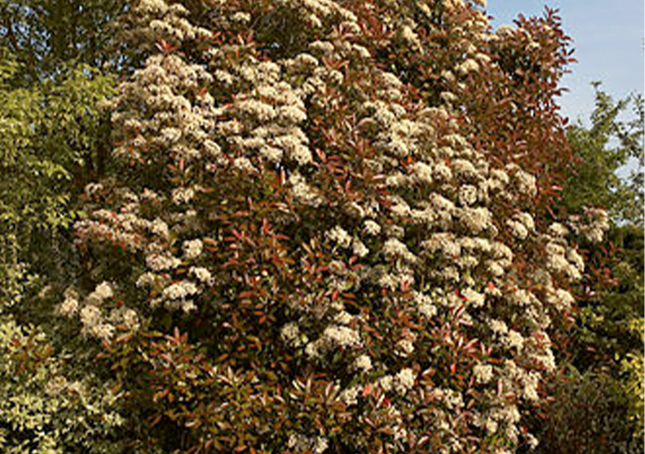Photinia

Photinia (/foʊˈtɪniə, fə-/) is a genus of about 40–60 species of small trees and large shrubs, but the taxonomy has recently varied greatly, with the genera Heteromeles, Stranvaesia and Aronia sometimes included in Photinia.
They are a part of the rose family (Rosaceae) and related to the apple. The botanical genus name derives from the Greek word photeinos for shiny and refers to the often glossy leaves. Most species are evergreen, but deciduous species also occur. The small apple-shaped fruit has a size of 4 to 12 mm and forms in large quantities. They ripen in the fall and often remain hanging on the bush until well into the winter. The fruits are used as food by birds, which excrete the seeds with their droppings and thereby distribute the plant.
The natural range of these species is restricted to warm temperate Asia, from the Himalaya east to Japan and south to India and Thailand. They have, however, been widely cultivated throughout the world as ornamentals for their white flowers and red fruits.
The scientific name Photinia is also widely used as the common name. Another name sometimes used is “Christmas berry”, but this name is a source of confusion, since it is commonly applied to plants in several genera including Heteromeles, Lycium, Schinus, and Ruscus. The name “photinia” also continues to be used for several species of small trees in the mountains of Mexico and Central America which had formerly been included in the genus Photinia.
Photinias typically grow from 4–15 m tall, with a usually irregular crown of angular branches; the branches are often (not always) thorny. The leaves are alternate, entire or finely toothed, varying between species from 3–15 cm in length and 1.5–5 cm wide; the majority of species are evergreen but several are deciduous.
The flowers are produced in early summer in dense terminal corymbs; each flower is 5–10 mm diameter, with five rounded white petals; they have a mild, hawthorn-like scent.
The fruit is a small pome, 4–12 mm across, bright red and berry-like, produced large quantities, maturing in the fall and often persisting well into the winter. The fruit are consumed by birds, including thrushes, waxwings and starlings; the seeds are dispersed in their droppings. Photinia species are sometimes used as food plants by the larvae of some Lepidoptera species including common emerald, feathered thorn and setaceous Hebrew character. Photinias are subject to leaf blight.
